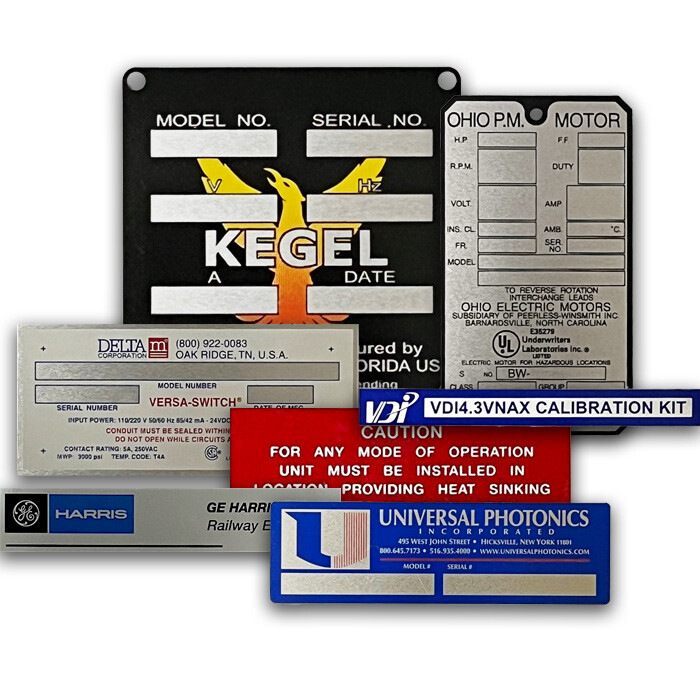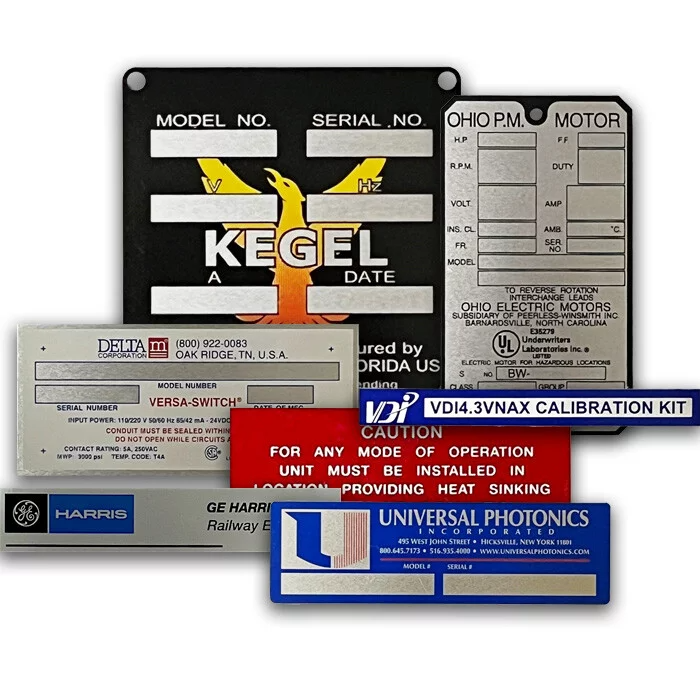
Understanding the Role of Custom Equipment Nameplates
In high-precision industries such as aerospace, medical devices, manufacturing, and electronics, compliance with regulations isn’t just a best practice—it’s a necessity. Regulatory compliance ensures that equipment is safe, reliable, and meets specific performance standards. One often-overlooked but critical element in ensuring compliance is the custom equipment nameplate. These nameplates are not merely identification tags; they are integral in meeting regulatory requirements, ensuring safety, and streamlining the maintenance process.
Custom equipment nameplates play an essential role in ensuring that your equipment meets various regulatory standards, reducing the potential for costly mistakes during inspections or audits. This post explores how custom equipment nameplates help companies stay compliant with industry regulations, ease inspections, and improve overall quality control.
What Defines an Equipment Nameplate?
An equipment nameplate is a durable metal or plastic plate attached to machinery or devices, containing critical operational and safety information. The nameplate provides both identifying information and essential details regarding regulatory compliance, which ensures that the equipment operates as intended and meets the required safety standards.
The nameplate is designed to withstand harsh conditions such as extreme temperatures, exposure to chemicals, and physical wear and tear. Because of its durability, an equipment nameplate is a permanent, reliable source of information, ensuring the data remains legible throughout the lifecycle of the equipment. This durability ensures that compliance information is always available when needed, even years after installation.
In high-risk industries such as aerospace and medical devices, regulatory authorities require clear identification on all machinery. The data on these nameplates is crucial for audits, recalls, or inspections. Therefore, ensuring that nameplates are properly affixed and contain the required information is vital for meeting compliance.
Key Information Included on Compliant Equipment Nameplates
The accuracy of the data displayed on nameplates is paramount. Here are the most critical elements often found on compliant equipment nameplates across industries:
- Serial Numbers
Serial numbers allow for tracking individual pieces of equipment, ensuring each item is identifiable. This is essential for maintenance, repairs, and audits. Serial numbers also allow manufacturers to pinpoint devices for recalls, updates, or part replacements, minimizing the risk of using non-compliant equipment. - Model Information
The model number is an integral part of ensuring compliance. It helps identify the exact type of equipment and version, which is crucial when verifying the equipment against safety standards and manufacturer specifications. This also allows workers to verify that they are using the right equipment or parts for a particular job, reducing the likelihood of operational issues or accidents. - Manufacturer Information
Including the manufacturer’s name, logo, and contact information ensures transparency. Regulatory authorities may need to reach out to manufacturers for more details on the product or for addressing recalls or compliance questions. It also serves as a verification tool to check whether the equipment meets safety and quality guidelines during audits. - Safety Symbols
Safety symbols are critical for indicating potential hazards associated with the operation of the equipment. These symbols ensure operators understand safety precautions, helping prevent accidents and ensuring compliance with health and safety regulations. For example, electrical hazard symbols are often used on equipment that handles high-voltage power. - Regulatory Certification Marks
Certain certifications must be included to indicate that the equipment meets required safety standards. These include certifications from organizations such as the FDA, ANSI, or UL (Underwriters Laboratories). Regulatory marks serve as confirmation that the product has passed required testing and quality assessments. These marks are vital in reassuring both the user and the regulatory authorities that the product is safe and effective for its intended use. - Environmental Conditions
Information about the equipment’s operating environment is often displayed on nameplates, especially in industries like aerospace and medical devices. This may include details such as operational temperature ranges, humidity levels, or pressure conditions under which the equipment is designed to operate. In medical devices, for example, it is crucial to indicate the temperature range to ensure proper function and patient safety.
Meeting Compliance Standards with Custom Nameplates
Custom nameplates help ensure compliance with various industry regulations, including those enforced by key regulatory bodies like OSHA, ANSI, FDA, and UL. Let’s look at some of the standards each body requires and how nameplates support compliance:
- OSHA Compliance
OSHA mandates that machinery and equipment in workplaces be properly labeled to indicate safety hazards. Clear markings, including model and serial number information, safety symbols, and other critical data, are required to meet OSHA regulations. Proper labeling is essential for reducing workplace accidents and ensuring the protection of employees. Failure to meet OSHA’s compliance requirements can result in costly penalties, and more importantly, risk to worker safety. - ANSI Compliance
ANSI sets standards for the identification of equipment for safety and operational purposes. Ensuring that equipment is properly labeled helps businesses meet ANSI’s standards, which are crucial for maintaining a safe working environment. Accurate identification ensures that the equipment can be used safely, helping prevent accidents and increasing workplace efficiency. - FDA Compliance
For industries involved in medical devices, FDA regulations require that equipment nameplates contain specific data, such as the device’s serial number, relevant certifications, and any operational restrictions. These markings are essential for passing FDA inspections, ensuring that medical devices are safe for patient use. With FDA regulations becoming more stringent, companies must ensure that their equipment complies with all necessary safety and operational standards to avoid fines or equipment recalls. - UL Certification
UL certification is particularly important for electrical and electronic devices. UL’s stringent safety testing protocols require manufacturers to display the UL logo and other relevant safety marks on their equipment’s nameplate. This certification reassures consumers and regulatory authorities that the equipment has undergone thorough safety checks to minimize risks, such as electrical malfunctions or fire hazards.
How Nameplates Support Inspections and Audits
Custom nameplates streamline the audit and inspection process by providing easily accessible and verifiable compliance information. Compliance officers and auditors can quickly confirm that equipment meets required standards, reducing the time and complexity of the inspection process. This is especially important during audits where time is critical.
With serial numbers, model details, and safety certifications all clearly displayed, inspections become more efficient. Furthermore, custom nameplates make it easier to track and trace equipment over its lifetime, ensuring that it has been maintained, serviced, and properly updated according to the manufacturer’s guidelines. This significantly reduces the potential for non-compliant equipment passing through audits undetected.
Permanent Marking Methods in Regulatory Compliance
One of the most critical aspects of custom equipment nameplates is their durability. Many industries rely on permanent marking methods to ensure that the information remains legible and intact throughout the equipment’s lifecycle. Methods like engraving, laser etching, and embossing ensure that nameplate data can withstand the harshest environments without fading or eroding.
For example, laser etching is a common and effective technique that creates highly legible markings resistant to abrasion, chemicals, and extreme weather conditions. Laser-etched nameplates are especially crucial in industries such as aerospace, where equipment often faces extreme temperatures and pressure conditions.
Ensuring Ongoing Compliance and Quality Control
Beyond regulatory compliance, custom nameplates also support quality control efforts. Clear and consistent labeling allows for easy identification of equipment, making it simple to verify its compliance status during regular maintenance or quality assurance checks. This ensures that only fully compliant and safe equipment remains in operation, reducing the risk of equipment failures and accidents.
In addition to safety, proper labeling with serial numbers, certification marks, and safety symbols also enhances quality audits. By keeping a record of every inspection and service event, custom nameplates provide an easily traceable history of the equipment’s operational status, ensuring that it’s always in optimal working condition.
Conclusion: Stay Compliant and Efficient with Custom Equipment Nameplates
Custom equipment nameplates are essential for maintaining compliance with industry standards. They ensure that critical information such as model numbers, serial numbers, safety symbols, and certification marks are readily available for inspection, audit, and quality control. By using permanent marking methods, custom nameplates remain legible throughout the equipment’s lifecycle, supporting regulatory compliance and operational efficiency.
Ensure your equipment is compliant and ready for inspection with high-quality custom nameplates. At Data Graphics Inc., we offer durable, compliant, and tailored solutions to meet your specific needs. Contact us today to get started on your custom nameplate project and ensure your equipment remains safe, reliable, and fully compliant.




